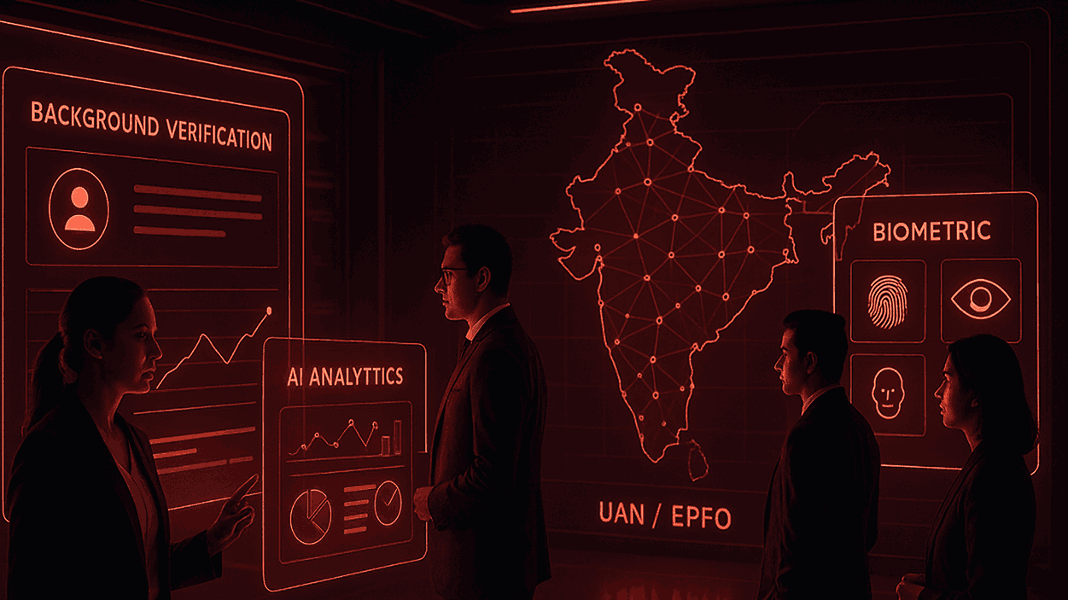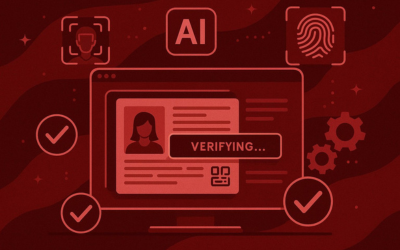Employee Background Verification Trends in BFSI

Next-Gen Employee Background Verification in BFSI: Key Trends, Tools, and Tech-Driven Transformation
In India’s evolving BFSI (Banking, Financial Services, and
Insurance) sector, employee background verification has become essential
for ensuring secure and compliant operations. With digital transformation
sweeping through the industry, verifying employment history, salary data, and
identity details helps prevent financial fraud and boosts lending reliability.
As customer acquisition becomes more digitized, institutions
need smarter, faster, and more trustworthy verification methods. This blog
explores the key trends, technologies, and verification solutions
revolutionizing the way employee background checks are done in BFSI.
Table of Contents
- Why
Employee Background Verification is Critical in BFSI
- Sector-Specific
Challenges: A Surge in Employment-Related Discrepancies
- The
Shift to Digital: A New Era for Verification
- Government
Initiatives Enabling Seamless Verification
- Role
of Artificial Intelligence in Employment Risk Analysis
- Employment
Verification Products Transforming BFSI Screening
- Industry
Insights and Future Landscape
- The
Road Ahead: Emerging Trends in Employment Verification
- Conclusion
- Frequently
Asked Questions (FAQs)
Why Employee Background Verification is Critical in BFSI
Employee verification is no longer a back-office task—it’s a
critical front-line defense for the BFSI sector. Financial institutions rely on
accurate employment records to:
- Evaluate
an individual’s income stability before loan disbursement.
- Detect
misrepresentation or falsified job information.
- Fulfill
KYC (Know
Your Customer) and AML requirements.
- Underwrite
salary-based products such as personal loans and credit cards.
- Prevent
identity fraud, fake employment records, and ghost job profiles.
Sector-Specific Challenges: A Surge in Employment-Related Discrepancies
Recent trends show a significant rise in background check
failures in BFSI. In FY 2023–24 alone, employment-related discrepancies hit
10.4%, up over 18% from the previous year. These numbers highlight the growing
threat of:
- Document
forgery
- False
employment claims
- Manipulated
income proofs
- High-risk
retail loan applications
Learn how digital verification can eliminate such risks in
this blog on easy
identity verification.
The Shift to Digital: A New Era for Verification
Manual verifications are being phased out in favor of
real-time digital systems. Financial institutions are adopting:
- Employment
APIs integrated with EPFO and UAN for current job validation.
- Bank
account verification to check for regular salary credits.
- Payroll
integration for double-checking declared income.
- GST-based
records for validating self-employed professionals and business
owners.
To understand how these modern systems power customer
onboarding, explore our guide to digital
eKYC verification.
Government Initiatives Enabling Seamless Verification
Government programs have accelerated access to verified
employment data:
- Aadhaar-based
eKYC enables identity-linked employment verification.
- EPFO
digitization ensures real-time job history tracking.
- Digital
India and Open Banking initiatives allow seamless data-sharing
with user consent.
- UAN-based
employment check is gaining traction as the gold standard.
Open banking is also powering platforms like Candy,
which streamline multi-point integrations across geographies.
Role of Artificial Intelligence in Employment Risk Analysis
AI tools are playing a pivotal role in risk-based employee
screening. They can:
- Identify
employment gaps or job-hopping patterns.
- Detect
income inconsistencies or mismatched salary flows.
- Predict
job stability risks based on historical employment data.
- Flag
suspicious records using real-time AI-powered
fraud detection.
Many of these insights are made possible through AI-powered
identity verification and AI-OCR
verification tools that extract and analyze employment data at scale.
Employment Verification Products Transforming BFSI Screening
SprintVerify offers a comprehensive suite of digital
verification tools tailor-made for BFSI:
- Current
Employment Check – Fetches live employer data using PAN + UAN mapping.
- Employment
History Report – Captures past employment records linked to UAN.
- Multi-Anchor
Employment Matching – Verifies using PAN, mobile, or UAN where
multiple identifiers exist.
- UAN
Passbook Insight – Analyses salary deposits and employer contributions
to verify regular income.
- Bank
Statement Salary Analysis – Confirms salary credits and financial
stability from account statements.
- GST
Employment Validation – Checks business income proof for self-employed
individuals.
For B2B verifications, learn more about KYB
(Know Your Business) solutions that provide holistic company and employment
data checks.
Industry Insights and Future Landscape
Industry data confirms the growing demand for digital
employee verification:
- 40%
of retail loan defaults are tied to unstable job profiles or
unverifiable income.
- 34%
increase in fraud attempts linked to fake employment details in loan
applications.
- 70%
of top BFSI institutions have already integrated digital verification
into their workflows.
- 280
million+ EPFO subscribers provide a trusted data pool for UAN-based
checks.
The Road Ahead: Emerging Trends in Employment Verification
As the verification ecosystem evolves, we’re seeing the rise
of:
- Open
Banking APIs – These will dominate real-time verification across
partners and platforms.
- Pan-India
UAN adoption – As more companies register with EPFO, UAN checks will
become universal.
- AI-powered
predictive profiling – Tools that score employment risk based on
history and behavior.
- Blockchain-based
verification – Immutable and tamper-proof employment credentials for
high-stakes industries.
Future readiness also means compliance-readiness. Get
equipped by understanding the DPDP
Act and its impact on businesses.
Conclusion
In a landscape where creditworthiness, trust, and compliance
are paramount, employee background verification is not just a support
function—it is a business enabler. The BFSI sector can no longer afford to rely
on outdated manual checks. With solutions like those from SprintVerify,
institutions gain access to authentic, real-time, and regulation-ready
employment data.
By leveraging advanced verification tools, financial
institutions can:
- Minimize
loan fraud and bad debts.
- Streamline
customer onboarding processes while staying compliant.
- Improve
customer experience by reducing turnaround time.
- Increase
trust with regulators, partners, and consumers.
- Gain
a competitive edge in a digitally transforming financial landscape.
The future of BFSI will be built on verified trust—and
it starts with verified people.
Frequently Asked Questions (FAQs)
- Why
is employment verification critical in the BFSI sector?
It helps assess credit risk, ensures KYC compliance, and reduces fraud in loan and financial product disbursement.
- What
sources are commonly used in digital employment checks?
Common sources include EPFO/UAN data, salary account statements, payroll software, and GST returns for self-employed individuals.
- Is
UAN-based verification reliable?
Yes, UAN records cover over 280 million members in India and provide validated data directly from employers via EPFO.
- Can
self-employed professionals be verified too?
Absolutely. GST-based employment validation helps check income patterns and business legitimacy for self-employed individuals.
- How
does AI improve background verification?
AI tools detect employment gaps, income inconsistencies, and fraud red flags, enabling smarter and faster decision-making for BFSI institutions.
For a deeper look into how real-time APIs are transforming background checks in the financial sector, explore SprintVerify’s Employee Background Verification API solution tailored for BFSI organizations.






